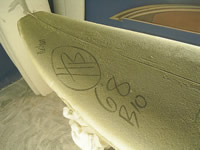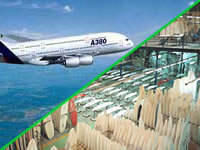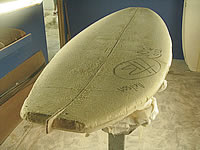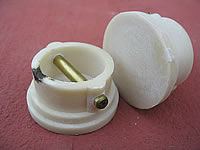Putting Our Money Where Our Mouth Is:
a Biofoam Project
Certainly some of our more cynical readers (including ourselves) have wondered where we come off with all this green business. And to be honest, Phoresia has been a real learning experience thus far.  But in order to put some of our ideas into practice we have come up with a self-serving scheme to build two new boards with the intent of using readily available materials by companies that are trying to take a step in the right direction. Ned McMahon at Home Blown Foam sent us a box of Biofoam blanks ordered with specific boards in mind that Florida based foam guru Tom Neilson will shape to our custom specifications. Each board will feature a bio-plastic leash plug from Greenlight Surfboard Supply and will be glassed with Resin Research epoxy resin with two layers of 6 oz. glass on the deck and one 6 oz. on the bottom by the guys at LP Glass in Florida.
But in order to put some of our ideas into practice we have come up with a self-serving scheme to build two new boards with the intent of using readily available materials by companies that are trying to take a step in the right direction. Ned McMahon at Home Blown Foam sent us a box of Biofoam blanks ordered with specific boards in mind that Florida based foam guru Tom Neilson will shape to our custom specifications. Each board will feature a bio-plastic leash plug from Greenlight Surfboard Supply and will be glassed with Resin Research epoxy resin with two layers of 6 oz. glass on the deck and one 6 oz. on the bottom by the guys at LP Glass in Florida.
We have learned through the last year of research some facts about the impact of surfboard manufacturing as a whole. Surfboards are a commodity, and as such are used by a limited number of people. The implications are that although the surfboard industry is not the most environmentally conscious, it does not have the same global impact as say the airline industry.  Surfboards are made using composites, meaning a combination of materials including petroleum based urethanes and resins. Some newer airplanes are also made using composite technology. For example, the new AirBus A380 uses 33 tons of composites in its construction of just one aircraft; compare that to the average surfboard, which uses about 4 pounds for a standard shortboard and around 12 pounds for the average longboard. 33 tons of composites could make 16,500 shortboards or 5,500 long boards. It’s easy to see that the surfboard industry as a whole is a very minor part in the grand scheme of things.
Surfboards are made using composites, meaning a combination of materials including petroleum based urethanes and resins. Some newer airplanes are also made using composite technology. For example, the new AirBus A380 uses 33 tons of composites in its construction of just one aircraft; compare that to the average surfboard, which uses about 4 pounds for a standard shortboard and around 12 pounds for the average longboard. 33 tons of composites could make 16,500 shortboards or 5,500 long boards. It’s easy to see that the surfboard industry as a whole is a very minor part in the grand scheme of things.
 In the next few weeks we’ll be covering a little more about the boards and the building process. We’ll also try to bring you some video footage of the creation on one of the boards as well as some shots of the boards in action. We welcome and encourage your comments so feel free to email us or post comments directly at the bottom of the post.
In the next few weeks we’ll be covering a little more about the boards and the building process. We’ll also try to bring you some video footage of the creation on one of the boards as well as some shots of the boards in action. We welcome and encourage your comments so feel free to email us or post comments directly at the bottom of the post.
Perhaps we could see our “green friendly” surf products lifestyle as a metaphor for how we could direct the rest of our consumer lives.  Imagine if we were as diligent in making conscious purchases with the rest of our daily things as we are with our boards? Or imagine if surfers as a collective adopted this mindset as a lifestyle? Then the impact would be felt and surfing would be more like the days of man and ocean. It’s really not that hard to find available alternatives to the status quo. Anyone can order a blank from Homeblown, buy Greenlight leash plugs online, and it’s not difficult to find a glass shop that will do epoxy glass jobs. This is exactly what we have done. It’s not the Holy Grail, but it’s an intentional step in the right direction, and as consumers we can affect the industry by choosing how we spend our money and what products we support.
Imagine if we were as diligent in making conscious purchases with the rest of our daily things as we are with our boards? Or imagine if surfers as a collective adopted this mindset as a lifestyle? Then the impact would be felt and surfing would be more like the days of man and ocean. It’s really not that hard to find available alternatives to the status quo. Anyone can order a blank from Homeblown, buy Greenlight leash plugs online, and it’s not difficult to find a glass shop that will do epoxy glass jobs. This is exactly what we have done. It’s not the Holy Grail, but it’s an intentional step in the right direction, and as consumers we can affect the industry by choosing how we spend our money and what products we support.
Thanks for the examination of the first products that will lead us to the future of surfing. You are right these are the first steps but they are the necessary ones to go beyond where we are now.
While I disagree that surfboards are commodities – I think they are far more special than that – I do agree that the overall impact of surfboards compared to other industry is small. However that does not mean we shouldn’t be taking these steps. It’s the collective going in a better direction that ultimately has the most impact.
By the way, Tom’s shapes look great!